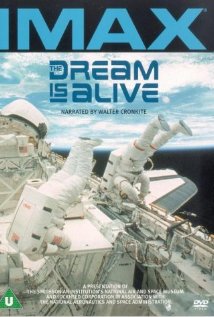Loading AI tools
1985 American film From Wikipedia, the free encyclopedia
The Dream is Alive is an American IMAX documentary film, released on June 1, 1985, about NASA's Space Shuttle program. The film was narrated by Walter Cronkite, and directed by Graeme Ferguson.
This article needs additional citations for verification. (September 2014) |
| The Dream Is Alive | |
|---|---|
 DVD cover | |
| Directed by | Graeme Ferguson |
| Written by | Toni Trow Myers |
| Produced by | Graeme Ferguson |
| Starring | David Leestma Jon A. McBride George Nelson Sally Ride Kathryn Dwyer Sullivan James Van Hoften |
| Narrated by | Walter Cronkite |
| Edited by | Toni Trow Myers |
| Music by | Micky Erbe Maribeth Solomon |
Production company | Threshold Corporation |
| Distributed by | IMAX Systems Corporation |
Release date |
|
Running time | 37 minutes |
| Country | United States |
| Language | English |
| Box office | $70 million[1] |
The documentary includes scenes from numerous shuttle missions, beginning with the dawn landing of Discovery at Kennedy Space Center's Shuttle Landing Facility upon the conclusion of STS-51-A. A composite shot, the finished sequence is composed of footage from Discovery's landing, radio transmissions from Challenger's 1984 landing on STS-41-B (the first mission to use the SLF runway), and runway approach footage filmed from a fixed-wing aircraft.
Mission STS-41-C, the 11th for the Shuttle program and the fifth for Challenger is featured most heavily, beginning with the deployment of the Long Duration Exposure Facility (LDEF) satellite. The capture and repair of the Solar Max satellite also receives a great deal of coverage, including a detailed overview of training for the mission in a large pool at NASA. This particular mission is of interest, as the first attempt at capturing the satellite failed, and a second attempt almost 12 hours later had to be made. That portion of the mission was a success, with the satellite being brought to the payload bay on the next attempt, and was repaired quickly by astronauts James van Hoften and George Nelson. Other STS 41-C mission activities included a student experiment located in a middeck locker to determine how honeybees make honeycomb cells in a microgravity environment.
Other shuttle missions are interspersed during the feature with the STS-41-C footage. Highlights include:
Additionally, a small amount of time is also dedicated to other aspects of the Space Shuttle program, including:
The film was produced and shot 15–18 months before the January 28, 1986, Challenger disaster, and includes appearances by two astronauts who died in the explosion; Francis Scobee and Judith Resnik. Challenger itself is featured prominently in the film. Many of the themes and tone of the documentary regarded the normalization of travel to space using the Shuttle while giving only passing mention to the dangers. The Challenger disaster would dramatically curtail this belief and subsequent experience would show that the shuttle would not make space travel more accessible or affordable.
By 1992, Variety reported that the film had grossed $70 million since its debut translating to $17 million in film rentals in the United States and Canada, the biggest IMAX 70mm film to that date.[1]
The Dream Is Alive was released on LaserDisc three times (twice in the US, once in Japan), DVD (pictured), and in high definition as a bonus feature on the Blue Planet HD DVD and Blu-ray in 2007.[2]
Seamless Wikipedia browsing. On steroids.
Every time you click a link to Wikipedia, Wiktionary or Wikiquote in your browser's search results, it will show the modern Wikiwand interface.
Wikiwand extension is a five stars, simple, with minimum permission required to keep your browsing private, safe and transparent.